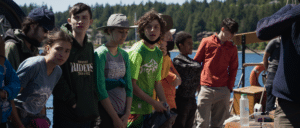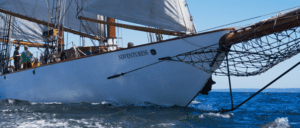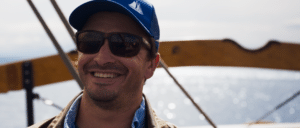Meet Nate Seward—captain of the schooner Adventuress—and step aboard the 110-year-old historic tall ship helping to get youth on the water.
Can you tell me your name and title?
My name is Nate Seward. I’m one of the captains of the Schooner Adventuress. I’ve been working on the Adventuress since 2009, and I’ve been captain for three years.
We host a youth education-based organization called Sound Experience. Typically, we’re working with kids between seventh grade and high school—getting them out on the water to see where they live from a different perspective.
For a lot of the people that come on this boat, it’s the first time that they’ve been on the water. We’re striving for appreciation of place and a realization that how you exist in that place matters.
What kind of changes have you seen amongst the kids who have sailed with the Adventuress?
That really varies. Sometimes it gives them a new lens—seeing that they could do things that were hard in a way that they had never thought to do before.
There was one kid who came to us through a community organization that works with homeless kids—he was living in a van with his mother. He went out sailing with us for an overnight trip, and then he just kept coming back. He kind of fell off the radar, but then he showed up about a year later, and he had gotten a job with one of the local towboat companies. He was working there making $50,000 a year and not living in a car anymore. He had chosen maritime trades as his career and gone on from there.
What kind of people are drawn to working on the Adventuress?
The people who are drawn to this work are pretty varied. Some of them are interested in history or boats or marine science and ecology. But they’re all interested in connecting with people. They have something that they’re passionate about that they want to preserve. Being on a traditional boat on the water is a good place to combine those things.
What sparked your interest in pursuing a career in the maritime industry?
I grew up in Port Townsend. My father worked in the boatyard, and I used to visit him on his lunch breaks. I was exposed to a lot of big, cool, old wooden boats—they kind of got under my skin.
The first time I remember going aboard the Adventuress was at one of the Port Townsend Wooden Boat Festivals when I was about seven. One of the crew members saw that I was enjoying what I was seeing, and they said I should come back. That was something that I remembered when I was in my early twenties and looking for a new job.
Why are people drawn to the Adventuress?
There was a past captain who used to talk about how there’s something special about this boat that makes people want to save it. She’s 110 years old and was burned and scuttled at every point along the way.
[For me,] it’s not an exaggeration to say that this boat feels like home. I mean, that first time when I came on—when I was six or seven years old—it just felt like a place that I wanted to be. I’ve worked on seven or eight other boats around the country, and I’ve always come back to this one. She’s just my favorite boat. There aren’t very many like it left, and this one is very well maintained.
I’ve had 14 years of seeing things evolve. All through the restoration process—new deck, engine, masts, sails—I either had a hand in them or watched the process. So it is a very personal level of investment in this ship and community.
What is it like to be at the helm of this ship on just the perfect day?
There’s a certain point when you’re on a boat—a beam reach [e.g., when the wind is blows directly onto the side of the vessel]—when the boat starts to heel over and she wants to dig in, but you can also feel her try to rise out of the water. It feels like she’s trying to fly. And I love that sensation, and it’s perfect. I like to say that it’s like flying a freight train. You can feel all the mass and the momentum, but it also feels like it’s trying to become light and wants to go into the air.
What do you enjoy the most about sailing in the Salish Sea?
I find the diversity of the environment here really compelling. Other places that I have sailed, there’s always kind of a toss-up between open water or interesting scenery. Here, you can have both in the same place.
My favorite is the San Juan Islands. You see different geology, different climates, and different ecology all within sight of each other. You can go from grasslands to rainforest to deserts and everything in between. It’s a really cool place to sail.



How would you define heritage?
I would define heritage as the continued practice of traditional skills without the constraints of tradition.
With traditional vessels, there is a tenacious aspect of people wanting to stay within the realm of “This is how they did it 100 years ago; this is how we’re going to do it now.” But I heard a shipwright a few years ago say, “If they had epoxy a hundred years ago, they would have used it.”
A really pertinent example of that: for the first time ever, we are allowed to sail with topsails while passengers are aboard, which has never been the case for us before. But that is now possible because of integration of modern fiber materials in our rig. It is made out of plastic, but it is applied in a traditional way on a traditional vessel, allowing us to deliver our mission from a traditional vessel, therefore perpetuating access to a traditional vessel.
Where and how do you feel most connected to the Maritime Washington National Heritage Area?
I feel the most connected to the heritage area when I am engaged in a project aboard this ship. Part of why I do what I do—and part of what I love about it—is that it allows me to engage with experts from all over the region who specialize in things like building sails, rigs, and traditional crafts. People who run lumber yards and mills, paint reps, engineers: it’s all encompassed in this ship. It allows me to see aspects of what makes this whole area run.
Is there a common trait shared by the people within the Maritime Washington National Heritage Area?
It is still very active. I worked with a captain on the East Coast who described [Washington] as the land of milk and honey. You can go to a lot of the towns here and buy pretty much anything you need to maintain your boat. It’s not a dying trade here. It’s still a place of innovation and progress. It’s still a way of life.
I hope that what the future holds for the Adventuress and Sound Experience is to continue changing with the times but also to keep finding the places where traditional sailing craft and hands-on experience are needed and relevant.
If you liked this interview, check out our other “This Is Maritime Washington” videos.
To learn more about Sound Experience and the Adventuress, please visit their website where you can find information about the ship, their mission, and upcoming events.




